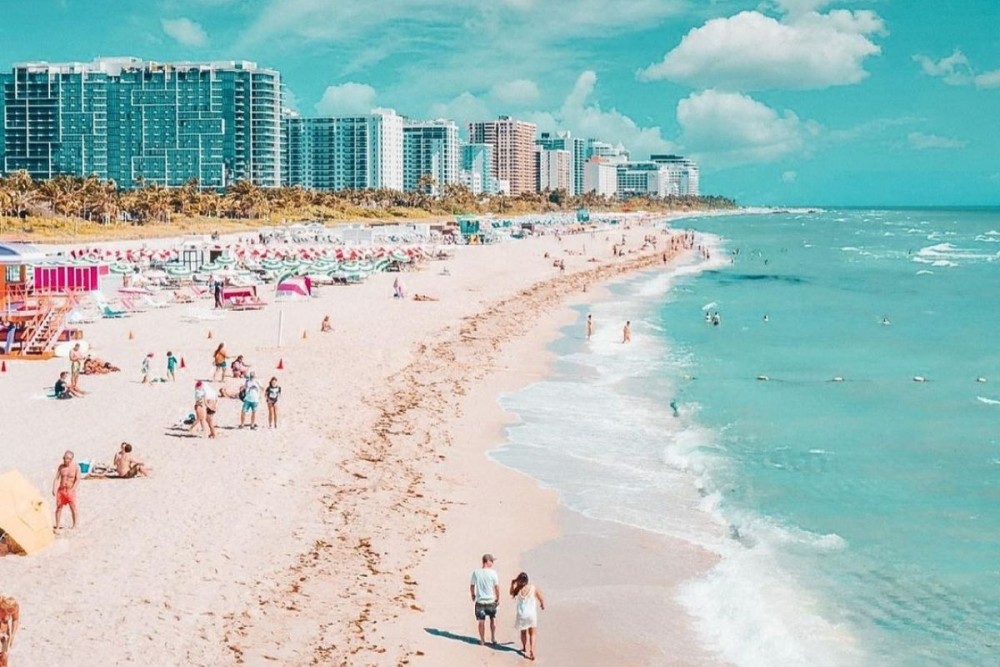South Beach beaches offer a vibrant tapestry of sun-kissed sands, turquoise waters, and Art Deco architecture. From the bustling energy of Ocean Drive to the quieter stretches further south, these beaches cater to diverse tastes, boasting a rich history and a thriving cultural scene. This guide delves into the geographical features, activities, cultural significance, environmental considerations, and safety aspects of this iconic destination, providing a comprehensive overview for both seasoned visitors and first-timers.
This exploration encompasses the unique characteristics of each beach section, comparing aspects like crowd levels, accessibility, and available amenities. We’ll also highlight the diverse range of water sports, land-based activities, and culinary experiences that make South Beach a truly unforgettable destination. The historical context, cultural events, and environmental preservation efforts will be examined, ensuring a complete understanding of this multifaceted coastal paradise.
Geographic Overview of South Beach Beaches
South Beach, a vibrant and iconic stretch of coastline in Miami Beach, Florida, boasts a diverse collection of beaches, each possessing its own unique character and appeal. The geographic location, encompassing a relatively narrow barrier island, dictates the overall beach experience, with the Atlantic Ocean to the east and Biscayne Bay to the west. The beaches themselves are characterized by their fine, white sand and generally calm, clear waters, though currents and wave conditions can vary.
South Beach Beach Sections and Their Characteristics
South Beach’s beaches aren’t a single, homogenous entity; rather, they are comprised of distinct sections, each offering a slightly different experience. The northernmost section, often considered part of North Beach, tends to be quieter and less crowded than the central areas. Moving south, the heart of South Beach unfolds, characterized by its bustling atmosphere, iconic Art Deco architecture, and a higher concentration of hotels and restaurants. Further south, the beach transitions into a more residential area, with a quieter, more relaxed ambiance.
Comparison of South Beach Beaches
While the sand remains largely consistent throughout South Beach—a fine, white quartz sand—the water conditions and overall atmosphere can vary depending on location and time of year. The northern sections generally experience calmer waters, while the central areas, particularly during peak season, can have more significant wave action. The atmosphere shifts from a more relaxed and family-friendly environment in the north to a lively and energetic vibe in the central section, known for its vibrant nightlife and beachside activities. The southernmost stretches offer a more tranquil retreat, ideal for those seeking a peaceful escape.
South Beach Beach Comparison Table
| Beach Name | Accessibility | Crowd Level (Weekday/Weekend) | Amenities |
|---|---|---|---|
| North Beach (adjacent to South Beach) | Excellent; ample parking and public transportation | Moderate/High | Lifeguards, restrooms, concessions, some beachside restaurants |
| Central South Beach (Ocean Drive area) | Excellent; high pedestrian traffic, limited parking | High/Very High | Lifeguards, restrooms, numerous concessions, many restaurants and bars |
| South of Fifth (SoFi) | Good; some street parking, public transportation | Moderate/High | Lifeguards, restrooms, some concessions, upscale restaurants and hotels |
Environmental Aspects of South Beach Beaches
South Beach’s vibrant ecosystem is intrinsically linked to its iconic beaches, creating a delicate balance that requires careful management. The area supports a diverse array of plant and animal life, impacting both the aesthetic appeal and the overall health of the beach environment. Understanding the environmental challenges and the conservation efforts undertaken is crucial to ensuring the long-term sustainability of this precious natural resource.
Local Ecosystem and its Relationship with the Beaches
The South Beach ecosystem is a complex interplay of marine and terrestrial environments. The sandy beaches provide nesting grounds for sea turtles, while the surrounding waters support a rich diversity of fish, invertebrates, and marine mammals. Coastal vegetation, such as seagrasses and mangroves (found in nearby areas like Biscayne Bay), play a critical role in stabilizing the shoreline, filtering pollutants, and providing habitat for various species. The health of these ecosystems directly impacts the quality and appeal of the beaches themselves. For example, healthy seagrass beds help maintain water clarity, while thriving mangrove forests protect the coastline from erosion. The beaches themselves act as a transition zone, supporting unique flora and fauna adapted to the harsh conditions of sand, sun, and saltwater spray.
Potential Environmental Threats to South Beach Beaches
South Beach faces several environmental threats. Coastal erosion, driven by rising sea levels and storm surges, poses a significant risk to the beaches’ physical integrity. Pollution from stormwater runoff, containing fertilizers, pesticides, and other pollutants, degrades water quality and harms marine life. Human activities, such as littering and excessive foot traffic, also contribute to environmental degradation. Furthermore, the introduction of invasive species can disrupt the natural balance of the ecosystem. For example, the proliferation of certain algae species can lead to harmful algal blooms, impacting water quality and marine life. Finally, climate change exacerbates many of these threats, increasing the frequency and intensity of storms and further contributing to sea-level rise.
Preservation and Protection Efforts
Significant efforts are underway to preserve and protect South Beach’s environment. The City of Miami Beach implements beach renourishment projects, pumping sand onto eroded areas to restore the beach’s width and protect coastal infrastructure. Stormwater management systems are being upgraded to reduce pollution from runoff. Environmental monitoring programs track water quality, coastal erosion, and the health of marine ecosystems. Public awareness campaigns educate visitors about responsible beach behavior, such as proper waste disposal and respecting wildlife. Furthermore, regulations are in place to limit development in sensitive coastal areas and protect endangered species. These initiatives, though costly and requiring ongoing commitment, demonstrate a dedication to environmental stewardship.
Sustainable Practices for Maintaining Ecological Health
Sustainable practices are increasingly incorporated into South Beach’s management. Recycling programs are implemented throughout the beach area, reducing waste sent to landfills. The use of eco-friendly cleaning products minimizes the impact on the marine environment. Efforts to reduce energy consumption and promote the use of renewable energy sources are also underway. Furthermore, promoting sustainable tourism practices, such as encouraging the use of public transportation and discouraging single-use plastics, helps minimize the environmental footprint of visitors. These efforts aim to balance the economic benefits of tourism with the need to protect the valuable natural resources of South Beach.
Visual Representation of South Beach Beaches
South Beach’s visual appeal is a potent blend of natural beauty and vibrant urban energy, creating a unique and unforgettable experience for visitors. The interplay of turquoise waters, soft sands, and the Art Deco architecture of the surrounding city forms a captivating backdrop for a diverse range of activities and human interactions. The visual character of the beach shifts dramatically throughout the day, reflecting the changing light and the rhythm of beach life.
The visual richness of South Beach is multifaceted. The color palette is dominated by the brilliant azure of the Atlantic Ocean, often punctuated by the white crests of waves breaking on the shore. The sand itself varies in hue from a pale, almost white, to a warm, golden beige, depending on the location and time of year. This natural color scheme is further enhanced by the vibrant colors of beach umbrellas, towels, and the clothing of sunbathers. The Art Deco buildings lining Ocean Drive, with their pastel hues and geometric designs, create a visually striking contrast to the organic forms of the ocean and sand.
Colors and Textures at Different Times of Day
The beach presents a different visual spectacle at various times of day. At dawn, a soft, diffused light bathes the scene in a tranquil, almost ethereal glow. The colors are muted, the ocean a calmer shade of blue, the sand reflecting the pale light. As the sun climbs higher, the colors intensify. The ocean shimmers with vibrant turquoise and azure, the sand glows warmly, and the shadows cast by the buildings create interesting patterns. Midday brings the brightest, most intense colors, with the sun reflecting brilliantly off the water and sand. As the sun begins to set, the scene transforms once more. The sky blazes with oranges, pinks, and purples, casting a warm, romantic light over the beach and the city. The ocean takes on a more reflective quality, mirroring the fiery hues of the sky. The textures of the beach also change throughout the day. The sand may appear dry and firm in the midday sun, while after a rain shower, it becomes smooth and glistening. The waves themselves offer a dynamic textural element, constantly changing in size, shape, and rhythm.
Typical Scenes on South Beach Beaches
South Beach is a vibrant tapestry of human activity. Sunbathers sprawl across the sand, their bodies bronzing under the sun’s rays. Groups of friends play lively games of beach volleyball, their laughter echoing across the expanse of sand. Swimmers glide through the clear, turquoise waters, their bodies creating fleeting trails of movement. Couples stroll hand-in-hand along the shoreline, their silhouettes framed against the setting sun. Street performers add to the visual spectacle, their music and artistry attracting crowds of onlookers. The visual energy is infectious, a dynamic blend of relaxation and exhilaration. Beach vendors add splashes of color with their carts, further enhancing the visual richness of the scene.
Visual Impact of Surrounding Architecture and Cityscape
The Art Deco architecture of South Beach is an integral part of the beach experience. The pastel-colored buildings, with their streamlined designs and geometric details, create a visually stunning backdrop for the ocean and sand. The iconic architecture adds a layer of sophistication and elegance to the beach scene, contrasting with the casual atmosphere of the beach itself. The juxtaposition of the organic forms of nature with the sharp lines of the buildings creates a visually engaging dynamic. From the beach, the cityscape stretches out, offering a panorama of skyscrapers and high-rises, providing a sense of urban energy and scale that complements the natural beauty of the shoreline. This blend of natural and urban elements is what makes the visual experience of South Beach so unique and compelling.
End of Discussion
South Beach’s allure extends far beyond its sun-drenched shores. The harmonious blend of natural beauty, vibrant culture, and architectural splendor creates an unparalleled experience. Whether you seek adrenaline-pumping water sports, leisurely strolls along the beach, or an immersion in the area’s rich history, South Beach offers something for everyone. This exploration has highlighted the diverse facets of this iconic destination, encouraging responsible enjoyment and appreciation for its unique character.


